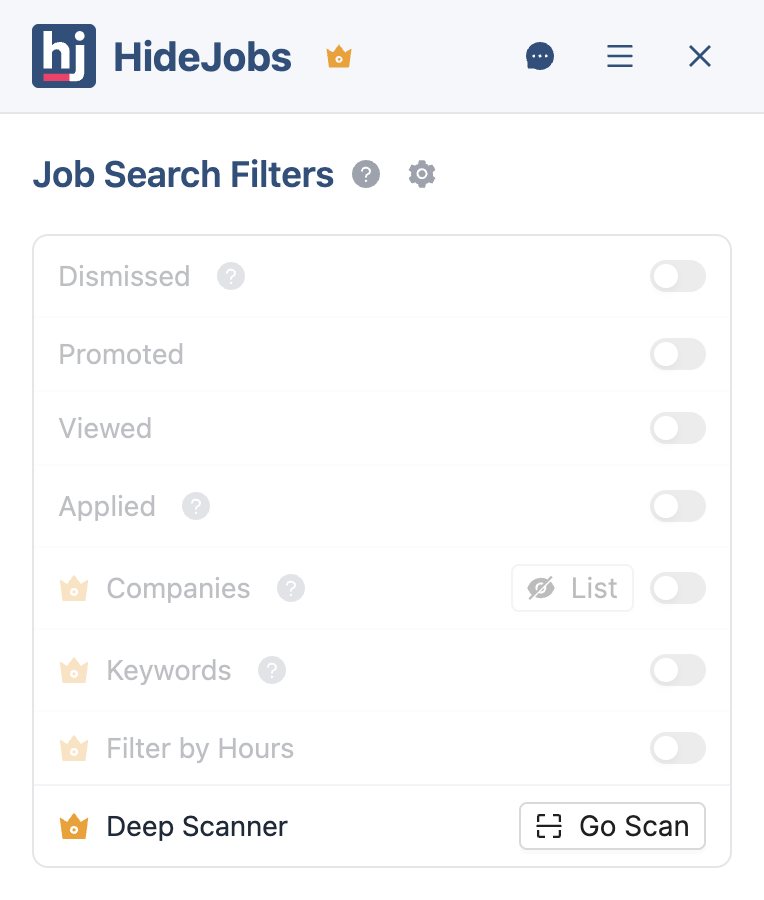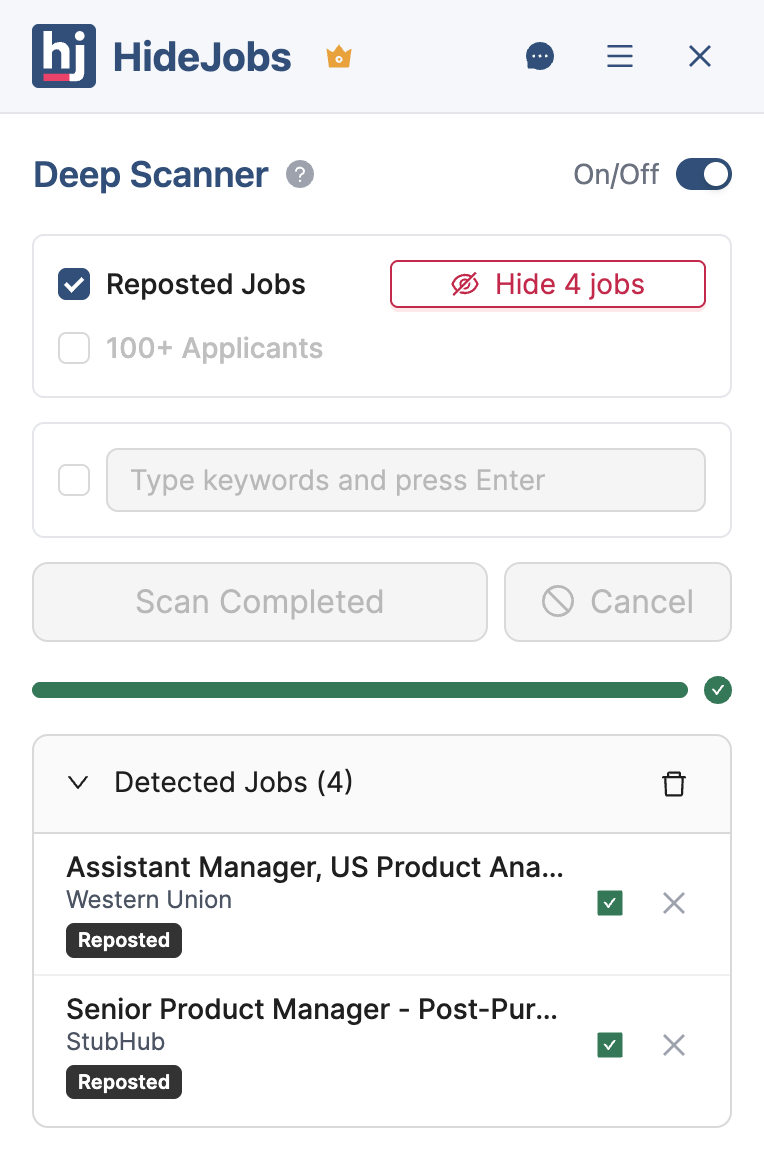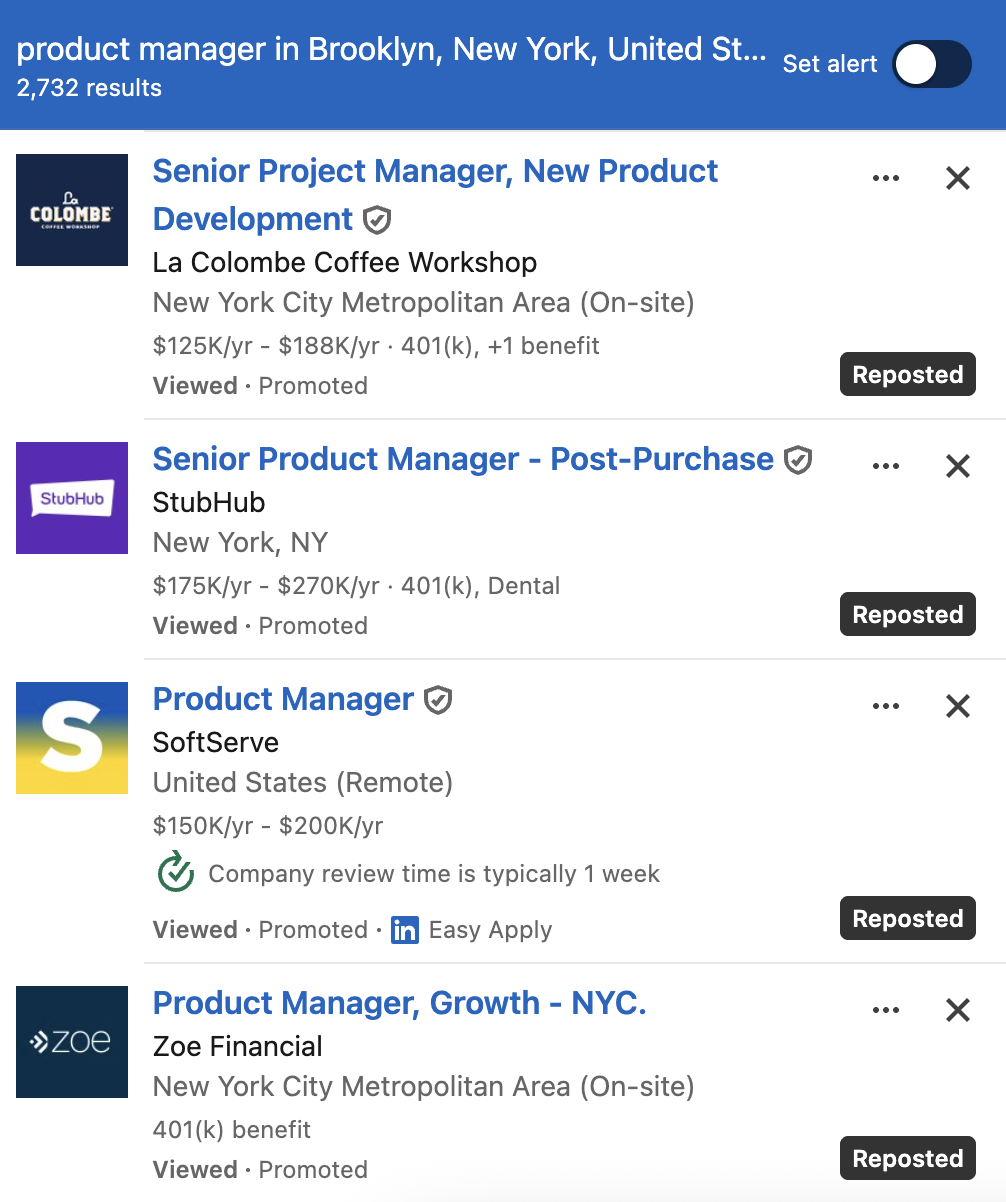Reposted jobs cluttering search results
LinkedIn shows you 25 jobs per page in your search results. When you search regularly, many of those 25 spots get filled with jobs you've already seen before—listings that appeared weeks ago, got refreshed by the employer, and now show up again. LinkedIn adds a small "Reposted" label but keeps them right there in your results, taking up valuable space on the page.
This creates a real problem when you're actively job hunting. After searching regularly for a few weeks, a significant portion of every search page consists of positions you've already reviewed. Instead of seeing 25 fresh opportunities, you might be seeing 10-12 new jobs and 13-15 jobs that were already there last week or last month.
The clutter makes it harder to find actual new openings. Your eyes have to constantly filter out the "Reposted" labels and focus only on the listings without that marker. When you're looking through hundreds of jobs, that mental filtering adds up. You lose time and miss opportunities buried among all the recycled listings.
Why employers repost jobs
Understanding why jobs get reposted helps you make better decisions about which reposted listings deserve your attention and which don't. There are several reasons why the same job appears repeatedly on LinkedIn.
Paid Promotion Cycles
According to LinkedIn's Recruiter documentation, promoted job posts run in cycles of 14-30 days. When a promoted post expires, employers can renew it to maintain visibility in search results. The renewal pushes the job back to the top of feeds, making it appear fresh even when the role has been open for months.
Expanding the Candidate Pool
Career guidance from Indeed explains that hiring teams often repost when initial candidates don't meet requirements or when they want to see a broader range of applicants. While this serves the employer, it creates confusion for candidates who may have already reviewed or applied to an earlier version of the listing.
Building Talent Pipelines
Recruiters writing on LinkedIn acknowledge that companies sometimes keep jobs posted to maintain a visible hiring presence and collect resumes for future opportunities, even when they're not actively filling a specific role.
Ghost Job Postings
Research from Resume Builder, which surveyed over 1,000 hiring managers, found that 3 in 10 companies currently have job postings listed with no immediate plans to fill them. The most common reasons include keeping options open during hiring freezes (48%), maintaining an impression of growth (43%), and building talent pools for future needs (37%).
Regardless of the employer's reason, the result is the same for you: search results filled with listings that may not represent genuine, immediate opportunities.
The cost to your job search
The frustration of seeing repeated jobs isn't just emotional—it represents real, measurable damage to your job search effectiveness. Here's what the research shows:
A 2024 report from Greenhouse found that job seekers are now applying to an average of 46 jobs before receiving an offer. One major contributor to this application fatigue is the sheer number of recycled and reposted listings appearing in search results.
When 20-30% of your search results are reposts or ghost jobs, the time waste adds up quickly. If you're actively searching and spending 10-15 hours per week reviewing positions, that means 2-4 hours weekly are going toward listings you've already evaluated. Over a typical 12-week job search, that's 24-48 hours—more than a full work week—spent on duplicate evaluation.
- Lost time. Every job listing requires mental energy: reading the description, comparing requirements, deciding whether to apply. When 25-30% of your results are duplicates, you're spending hours each week re-evaluating positions you've already considered.
- Missed opportunities. Reposted jobs don't just waste time—they push newer opportunities further down in your results. If you focus on the first 20-30 listings, fresh jobs appearing below recycled posts may never get your attention.
- Decision fatigue. Repeatedly evaluating the same information drains your decision-making capacity. This fatigue can lead to poor decisions about genuine opportunities or cause you to miss important details.
- Tracking confusion. When employers repost roles, it becomes difficult to remember whether you've already evaluated or applied to that listing. This uncertainty wastes mental energy and can cause you to skip opportunities unnecessarily.
How HideJobs filters them out
HideJobs Deep Scanner addresses the reposted jobs problem by working with LinkedIn's own repost indicators. Open the HideJobs filters panel and click "Go Scan" on the Deep Scanner filter. This opens the Deep Scanner panel where you can select "Reposted" and click "Start Scan" to begin detecting reposted jobs in your search results.
The scanner goes through your search results and identifies any job that LinkedIn has marked with a "Reposted X days ago" label. It adds a visible black badge to each reposted job card and saves them to your Scan History with the job title and company name.


You can immediately see which jobs are reposts right on the search results page without opening each one. If you want to hide them from view, simply turn on the "Hide Reposted" toggle—but you can also leave them visible with just the badges if you prefer to keep track of what's been reposted while still seeing everything.
Once the scan completes, you'll see the results immediately. The Deep Scanner panel shows a list of all detected reposted jobs with their titles and company names. Each flagged job on the search results page gets a black badge, so you can see at a glance which jobs are reposts without opening them. At this point, you can choose to turn on the "Hide Reposted" toggle to remove them from view, or leave the toggle off and just use the badges to identify reposts while keeping everything visible.


This works everywhere LinkedIn shows job listings—search results, recommended jobs, jobs by category. Anywhere a "Reposted" label exists, HideJobs can detect and flag it. You don't need to configure anything or maintain lists manually. HideJobs reads LinkedIn's own markers and handles everything automatically.
HideJobs only flags jobs that LinkedIn itself has labeled as reposted. You're working with the same information LinkedIn provides, but with the power to filter and track it systematically. All data is stored locally on your device—HideJobs doesn't upload your job search history or share information with anyone.
What changes with filtering
Having reposted jobs clearly labeled changes how efficiently you can search. With the black badges visible on every reposted job card, you can instantly identify which listings you've already seen without opening them. This alone speeds up your search significantly.
If you want to go further, turning on the "Hide Reposted" toggle removes those jobs from view entirely, so every job on your screen is genuinely new. The choice is yours—some people prefer to see everything with badges for full visibility, while others want reposts hidden completely to maximize focus.
Here's what improves with the Deep Scanner:
- Instant identification. The black badges let you spot reposted jobs immediately without opening each listing. You can scan your results faster because you know at a glance which jobs are recycled.
- Optional hiding. If you want a completely clean view, turn on the "Hide Reposted" toggle and those jobs disappear, leaving only fresh listings. If you prefer to see everything, leave the toggle off and just use the badges for awareness.
- Better focus. Whether you hide reposts or just label them, you're no longer guessing which jobs you've seen before. The mental energy you save on "have I reviewed this already?" can go toward evaluating actual opportunities.
- Less frustration. Seeing the same jobs repeatedly without knowing they're reposts is demoralizing. The badges give you clarity, and hiding gives you a clean workspace when you need it.
- Combined filtering. The Deep Scanner works alongside HideJobs' other filters. You can hide reposted jobs and unwanted companies at the same time, creating results that are both fresh and relevant to what you're looking for.
- Complete control. You can toggle hiding on and off anytime, check your Scan History to see what was detected, and unhide specific jobs if needed. Nothing is permanent—you maintain full visibility into what's happening.
Job searching already requires enough energy without fighting cluttered interfaces or wondering which jobs you've already reviewed. With HideJobs, you get clear badges on every reposted job card, so you always know what you're looking at. Whether you choose to hide those jobs or just keep them labeled, you're spending your time more effectively.
The time savings compound over a job search. Just having the badges visible can save you 5-10 minutes per session by eliminating guesswork. If you turn on hiding, you save even more by skipping past recycled listings entirely. Over a week, that becomes an hour. Over a month of active searching, you're reclaiming several hours that would otherwise go to repetitive evaluation. That's time you can redirect toward better applications, networking, or preparing for interviews.